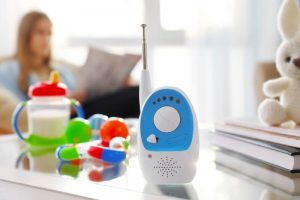Baby Monitors: Everything You Need to Know

The arrival of a new baby means filling your home with new accessories. Baby monitors are an essential part of welcoming the new addition to the family.
These devices allow you to stay connected to your child even when he or she isn’t under your watchful gaze.
Baby monitors allow you to respond quickly to the little one’s movements. However, it’s important to know exactly what you’re looking for before making a purchase.
Before buying your monitor, you need to consider some key factors and decide which features are most important, such as vibration, light, cameras, or night vision.
These characteristics vary from one model to the next. For this reason, we recommend making an accurate assessment of your needs before choosing the one you need.
Baby monitors
In this article, we’ll examine the options that may be most useful when it comes to choosing the best device for you.
1. Video and audio monitoring
An audio-only monitor is easy to use. The communication can be either one-way or two-way. In short, it allows you to listen to all the sounds your child makes while awake or asleep.
As a result, you’ll know exactly when he or she starts to cry or call out for attention. In addition, you can move freely around the house while remaining available to your little one.
The incorporation of video monitoring allows you to both see and listen to your baby. The type of baby monitor can offer continuous transmission for keeping constant track of your child.
These monitors use a camera mounted on the wall or on a table in the baby’s room, and a video interface that allows you to control it from anywhere. Most screens offer high-definition resolution, and some have even integrated night vision for round-the-clock surveillance.

2. Wi-Fi Connectivity
Baby monitors with Wi-Fi allow you to watch over your child via a video app you can download to your phone or tablet.
This type of device is perfect for busy parents while they’re at the office, or have to leave the house, entrusting their child to a babysitter or nanny.
Monitors with WiFi use secure channels to transmit video over wireless networks. In addition, notifications are sent to your device when sound or movement is detected in the room.
3. Ambient temperature tracking
Some devices can detect the ambient temperature of the room through a thermostat. As such, you can attend to your child’s comfort from a distance. They even allow you to control a room’s temperature when a window is open.
“Baby monitors allow you to respond quickly to the little one’s movements.”
4. Two-way intercom
A two-way intercom will let you both hear and speak to your baby. Some baby monitors even offer the ability to play audio.
This option enables you to play lullabies to calm the child without creating too much of a distraction. There are also models that come with additional features such as night lights.
5. Zoom, tilt and rotate
Once children are old enough to walk, it becomes easy to lose sight of them. For this reason, some baby monitors come with tilt and rotate functions that let you adjust the camera to follow your baby’s movements.
The zoom function is useful if you want to record videos or take screenshots with your monitor.

6. Motion sensors
Certain monitors come equipped with motion detectors to be placed under the baby’s mattress. They can alert you when no movement is detected for 20 or more seconds.
This type of monitor is ideal for newborns, as well as for babies who are beginning to move around and explore their universe. Note: it’s recommended to use it without the motion detector in the early years of childhood.
In short, baby monitors should be selected according to the situation and the layout of the child’s room.
A monitor should allow for safe and effective tracking from every room in the house. You should consider the device’s range of signal. This way, you can avoid interference from other electronic devices in your home.
This text is provided for informational purposes only and does not replace consultation with a professional. If in doubt, consult your specialist.








